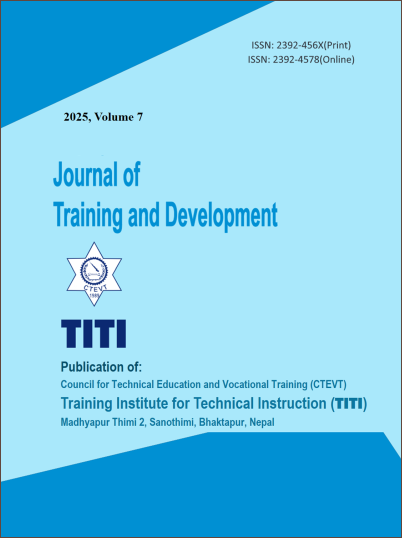Impact of Technical and Vocational Education and Training on ABCD Approach in Nepal
DOI:
https://doi.org/10.3126/jtd.v7i1.74980Keywords:
empowerment, vocational education, community development, social cohesion, paradigmAbstract
Technical and Vocational Education and Training (TVET) aims to equip individuals with skills that are in demand and likely to remain relevant in the long term, promoting economic sustainability. Asset-Based Community Development (ABCD) seeks to build on local assets and capacities, creating solutions that are sustainable because they are rooted in the community itself. TEVT and ABCD both support holistic development connecting effective framework, paying particular attention to social cohesion, economic resilience, and community empowerment. The findings underscore the pivotal role of TVET courses in equipping individuals with employable skills and talents, enabling them to actively drive transformative changes within their communities. By fostering entrepreneurship, expanding livelihood opportunities, and strengthening social networks, TVET programs significantly contribute to inclusive development outcomes, spur economic growth, and facilitate poverty reduction. However, the integration of TVET into the ABCD framework faces substantial challenges, including limited funding, socioeconomic disparities, and legal restrictions, which hinder its effective implementation. Despite these obstacles, there remains significant potential for innovation, collaboration, and legislative enhancement to address these issues and optimize the benefits of TVET for community development. In essence, this article examines into the intricate ways in which Technical and Vocational Education and Training (TVET) is woven into Nepal's Asset-Based Community Development (ABCD) paradigm. This includes integration of TVET within the ABCD paradigm holding the considerable promise for fostering community.
Downloads
Downloads
Published
How to Cite
Issue
Section
License

This work is licensed under a Creative Commons Attribution 4.0 International License.
Authors who publish with this journal agree to the following terms:
- Authors retain copyright and grant the journal right of first publication with the work simultaneously licensed under a Creative Commons Attribution License that allows others to share the work with an acknowledgement of the work's authorship and initial publication in this journal.
- Authors are able to enter into separate, additional contractual arrangements for the non-exclusive distribution of the journal's published version of the work (e.g., post it to an institutional repository or publish it in a book), with an acknowledgement of its initial publication in this journal.
- Authors are permitted and encouraged to post their work online (e.g., in institutional repositories or on their website) prior to and during the submission process, as it can lead to productive exchanges, as well as earlier and greater citation of published work (See The Effect of Open Access).




